Askeland D.R., Fulay P.P. Essentials of Materials Science & Engineering
Подождите немного. Документ загружается.


Phase Transformations Aluminum bronzes that contain over 9% Al can form b phase
on heating above 565
C, the eutectoid temperature [Figure 14-6(c)]. On subsequent
cooling, the eutectoid reaction produces a lamellar structure (like pearlite) that contains
a brittle g
2
compound. The low-temperature peritectoid reaction, a þ g
2
! g, normally
does not occur. The eutect oid product is relatively weak and brittle, but we can rapidly
quench the b to produce martensite, or b
0
, which has high strength and low ductility.
When b
0
is subsequently tempered, a combination of high strength, good ductility, and
excellent toughness is obtained as fine platelets of a precipitate from the b
0
.
Leaded-Copper Alloys Virtually any of the wrought alloys may contain up to 4.5% Pb.
The lead forms a monotectic reaction with copper and produces tiny lead spheres as
the last liquid to solidify. The lead improves machining characteristics. Use of leaded-
copper alloys, however, has a major environmental impact and, consequently, new alloys
that are lead free have been developed. The following two examples illustrate the use of
copper-based alloys.
EXAMPLE 14-5
Design/Materials Selection for an Electrical Switch
Design the contacts for a switch or relay that opens and closes a high-current
electrical circuit.
SOLUTION
When the switch or relay opens and closes, contact between the conductive
surfaces can cause wear and result in poor contact and arcing. A high hardness
would minimize wear, but the contact materials must allow the high current to
pass through the connection without overheating or arcing.
Therefore, our design must provide for both good electrical conductivity
and good wear resistance. A relatively pure copper alloy dispersion strength-
ened with a hard phase that does not disturb the copper lattice would, perhaps,
be ideal. In a Cu-Al
2
O
3
alloy, the hard ceramic-oxide particles provide wear
resistance but do not interfere with the electrical conductivity of the copper
matrix. In fact, as the oxygen dissolved in the copper matrix is removed, the
conductivity actually increases. There are also other materials such as W-Ag
alloys that are also used.
EXAMPLE 14-6
Design of a Heat Treatment for a Cu-Al Alloy Gear
Design the heat treatment required to produce a high-strength aluminum-
bronze gear containing 10% Al.
SOLUTION
The aluminum bronze can be strengthened by a quench and temper heat
treatment. We must heat above 900
C to obtain 100% b for a Cu-10% Al alloy
[Figure 14-6(c)]. The eutectoid temperature for the alloy is 565
C. Therefore,
our recommended heat treatment is:
CHAPTER 14 Nonferrous Alloys450

1. Heat the alloy to 950
C and hold to produce 100% b.
2. Quench the alloy to room temperature to cause b to transform to marten-
site, b
0
, which is supersaturated in copper.
3. Temper below 565
C; a temperature of 400
C might be suitable. During
tempering, the martensite transforms to a and g
2
. The amount of the g
2
that
forms at 400
C is:
% g
2
¼
10 9:4
15:6 9:4
100 ¼ 9: 7%
4. Cool rapidly to room temperature so that the equilibrium g does not form.
Note that if tempering were carried out below about 370
C, g would form
rather than g
2
.
14-4 Nickel and Cobalt Alloys
Nickel and cobalt alloys are used for corrosion protection and for high-temperature
resistance, taking advantage of their high melting points and high strengths. Nickel is
FCC and has good formability; cobalt is an allotropic metal, with an FCC structure
above 417
C and an HCP structure at lower temperatures. Special cobalt alloys are
used for exceptional wear resistance and, because of biocompatibility for prosthetic de-
vices. Typical alloys and their applications are listed in Table 14-8.
TABLE 14-8 9 Compositions, properties, and applications for selected nickel and cobalt alloys
Tensile Yield
Strength Strength % Strengthening
Material (MPa) (MPa) Elongation Mechanism Applications
Pure Ni (99.9% Ni) 345 110 45 Annealed Corrosion resistance
655 621 4 Cold-worked Corrosion resistance
Ni-Cu alloys:
Monel 400 (Ni-31.5% Cu) 538 269 37 Annealed Valves, pumps, heat exchangers
Monel K-500 (Ni-29.5%
Cu-2.7% Al-0.6% Ti)
1034 759 30 Aged Shafts, springs, impellers
Ni superalloys:
Inconel 600 (Ni-15.5%
Cr-8% Fe)
621 200 49 Carbides Heat-treatment equipment
Hastelloy B-2 (Ni-28% Mo) 896 414 61 Carbides Corrosion resistance
DS-Ni (Ni-2% ThO
2
) 490 331 14 Dispersion Gas turbines
Fe-Ni superalloys:
Incoloy 800 (Ni-46%
Fe-21% Cr)
614 283 37 Carbides Heat exchangers
Co superalloys:
Stellite 6B (60% Co-30%
Cr-4.5% W)
1220 710 4 Carbides Abrasive wear resistance
14-4 Nickel and Cobalt Alloys 451
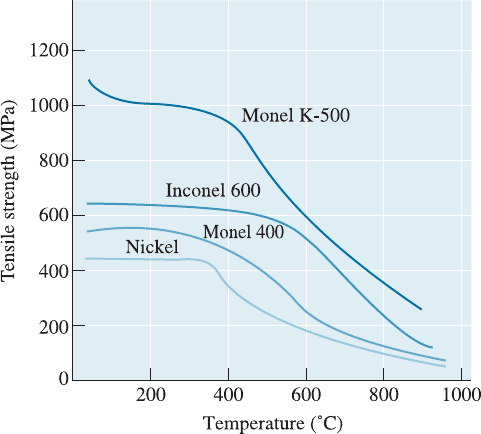
In Chapter 9, we saw how rapidly solidified powders of nickel- and cobalt-based
superalloys can be formed using spray atomization followed by hot isostatic pressing.
These materials are used to make the rings that retain turbine blades, as well as for
turbine blades for aircraft engines. In Chapter 12, we mentioned shape-memory alloys
based on Ni-Ti. Iron, nickel and cobalt are magnetic. Certain Fe-Ni- and Fe-Co-based
alloys form very good magnetic materials. A Ni-36% Fe alloy (Invar) displays practi-
cally no expansion during heating; this e¤ect is exploited in producing bimetallic com-
posite materials. Cobalt is used as a tough phase that absorbs shocks and vibrations in
WC-Co cutting tools.
Nickel and Monel Nickel and its alloys have excellent corrosion resistance and form-
ing characteristics. When copper is added to nickel, the maximum strength is obtained
near 60% Ni. A number of alloys, called monels, with approximately this composition
are used for their strength and corrosion resistance in salt water and at elevated tem-
peratures. Some of the monels contain small amounts of aluminum and titanium. These
alloys show an age-hardening response by the precipitation of g
0
, a coherent Ni
3
Al or
Ni
3
Ti precipitate which nearly doubles the tensile properties. The precipitates resist
overaging at temperatures up to 425
C (Figure 14-7).
Superalloys Nickel, iron-nickel, and cobalt alloys that contain large amounts of
alloying elements intended to produce a combination of high strength at elevated tem-
peratures, resistance to creep at temperatures up to 1000
C, and resistance to corrosion.
These superalloys excellent high-temperature properties are obtained even though the
melting temperatures of the alloys are about the same as that for steels. Typical
applications include vanes and blades for turbine and jet engines, heat exchangers,
chemical reaction vessel components, and heat-treating equipment.
To obtain high strength and creep resistance, the alloying elements must produce
a stable microstructure at high temperatures. Solid-solution strengthening, dispersion
strengthening, and precipitation hardening generally are employed.
Figure 14-7
The effect of temperature
on the tensile strength of
several nickel-based
alloys.
CHAPTER 14 Nonferrous Alloys452
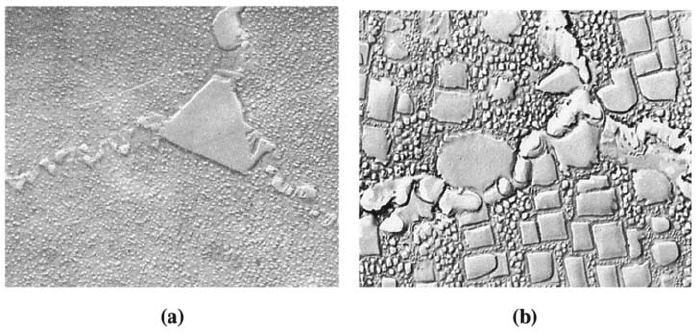
Solid-Solution Strengthening Large additions of chromium, molybdenum, and tung-
sten and smaller additions of tantalum, zirconium, niobium, and boron provide solid-
solution strengthening. The e¤ects of solid-solution strengthening are stable and, con-
sequently, make the alloy resistant to creep, particularly when large atoms such as
molybdenum and tungsten (which di¤use slowly) are used.
Carbide-Dispersion Strengthening All alloys contain a small amount of carbon
which, by combining with other alloying elements, produces a network of fine, stable
carbide particles. The carbide network interferes with the dislocation movement and
prevents grain boundary sliding. The carbides include TiC, BC, ZrC, TaC, Cr
7
C
3
,
Cr
23
C
6
,Mo
6
C, and W
6
C, although often they are more complex and contain several
alloying elements. Stellite 6B, a cobalt-based superalloy, has unusually good wear re-
sistance at high temperatures due to these carbides.
Precipitation Hardening Many of the nickel and nickel-iron superalloys that contain
aluminum and titanium form the coherent precipitate g
0
(Ni
3
Al or Ni
3
Ti) during aging.
The g
0
particles (Figure 14-8) have a crystal structure and lattice parameter similar to
that of the nickel matrix; this similarity leads to a low-surface energy and minimizes
overaging of the alloys, providing good strength and creep resistance even at high
temperatures.
By varying the aging temperature, precipitates of various sizes can be produced.
Small precipitates, formed at low-aging temperatures, can grow between the larger
precipitates produced at higher temperatures, therefore increasing the volume percent-
age of the g
0
and further increasing the strength [Figure 14-8(b)].
The high-temperature use of the superalloys can be improved when a ceramic
coating is used. The next example shows the application of a nickel-based superalloy.
Figure 14-8 (a) Microstructure of a superalloy, with carbides at the grain boundaries and
g
0
precipitates in the matrix (15,000). (b) Microstructure of a superalloy aged at two
temperatures, producing both large and small cubical g
0
precipitates (10,000). (ASM
Handbook, Vol. 9, Metallography and Microstructure (1985), ASM International, Materials
Park, OH 44073.)
14-4 Nickel and Cobalt Alloys 453

EXAMPLE 14-7 Design/Materials Selection for a High-Performance Jet Engine
Turbine Blade
Design a nickel-based superalloy for producing turbine blades for a gas turbine
aircraft engine that will have a particularly long creep-rupture time at temper-
atures approaching 1100
C.
SOLUTION
First, we need a temperature stable microstructure. Addition of aluminum or
titanium permits the precipitation of up to 60 vol% of the g
0
phase during heat
treatment and may permit the alloy to operate at temperatures approaching
0.85 times the absolute melting temperature. Addition of carbon and alloying
elements such as Ta and Hf permits the precipitation of alloy carbides that pre-
vent grain boundaries from sliding at high temperatures. Other alloying elements,
including molybdenum and tungsten, provide solid-solution strengthening.
Second, we might produce a directionally solidified or even single-crystal
turbine blade (Chapter 9). In directional solidification, only columnar grains
form during freezing, eliminating transverse grain boundaries that might
nucleate cracks. In a single crystal, no grain boundaries are present. We might
use the investment casting process, being sure to pass the liquid superalloy
through a filter to trap any tiny inclusions before the metal enters the ceramic
investment mold.
We would then heat treat the casting to assure that the carbides and g
0
precipitate with the correct size and distribution. Multiple aging temperatures
might be used to assure that the largest possible volume percent g
0
is formed.
Finally, the blade might contain small cooling channels along its length. Air
for combustion in the engine can pass through these channels, providing active
cooling to the blade, before reacting with fuel in the combustion chamber.
14-5 Titanium Alloys
Titanium is traditionally produced from TiO
2
by the Kroll process. The TiO
2
is con-
verted to TiCl
4
(titanium tetra chloride, also informally known as tickle!), which is
subsequently reduced to titanium metal by sodium or magnesium. The resultant tita-
nium sponge is then consolidated, alloyed as necessary, and processed using vacuum
arc melting. Recently, a new electrochemical process for the production of titanium
sponge directly from TiO
2
has been reported. Titanium provides excellent corrosion
resistance, high specific strength, and good high-temperature properties. Strengths up to
1380 MPa, coupled with a density of 4.505 g/cm
3
, provide excellent mechanical prop-
erties. An adherent, protective TiO
2
film provides excellent resistance to corrosion and
contamination below 535
C. Above 535
C, the oxide film breaks down and small
atoms such as carbon, oxygen, nitrogen, and hydrogen embrittle the titanium.
Titanium’s excellent corrosion resistance provides applications in chemical process-
ing equipment, marine components, and biomedical implants such as hip prostheses.
Titanium is an important aerospace material, finding applic ations as airframe and jet
engine components. When it is combined with niobium, a superconductive intermetallic
compound is formed; when it is combined with nickel, the resulting alloy displays the
CHAPTER 14 Nonferrous Alloys454
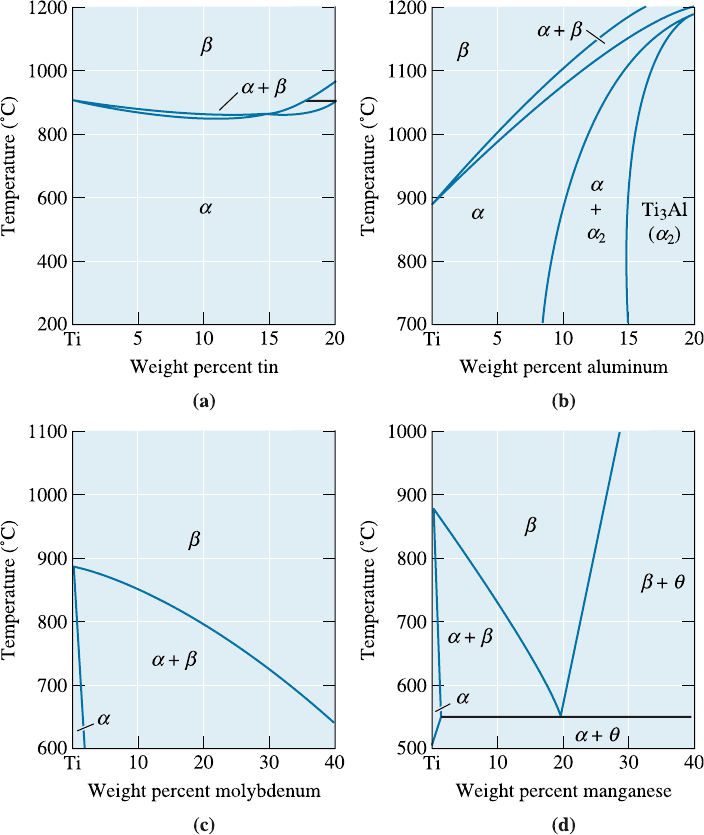
shape-memory e¤ect; when it is combined with aluminum, a new class of intermetallic
alloys is produced, as discussed in Chapter 11. Titanium alloys are used for sports
equipment such as the heads of golf clubs.
Titanium is allotropic, with the HCP crystal structure (a) at low temperatures and
a BCC structure (b) above 882
C. Alloying elements provide solid-solution strengthen-
ing and change the allotropic transformation temperature. The alloying elements can be
divided into four groups (Figure 14-9). Additions such as tin and zirconium provide
solid-solution strengthening without a¤ecting the transformation temperature. Alumi-
num, oxygen, hydrogen, and other alpha-stabilizing elements increase the temperature
at which a transforms to b. Beta stabilizers such as vanadium, tantalum, molybdenum,
and niobium lower the transformation temperature, even causing b to be stable at room
temperature. Finally, manganese, chromium, and iron produce a eutectoid reaction,
Figure 14-9 Portions of the phase diagrams for (a) titanium-tin, (b) titanium-aluminum,
(c) titanium-molybdenum, and (d) titanium-manganese.
14-5 Titanium Alloys 455
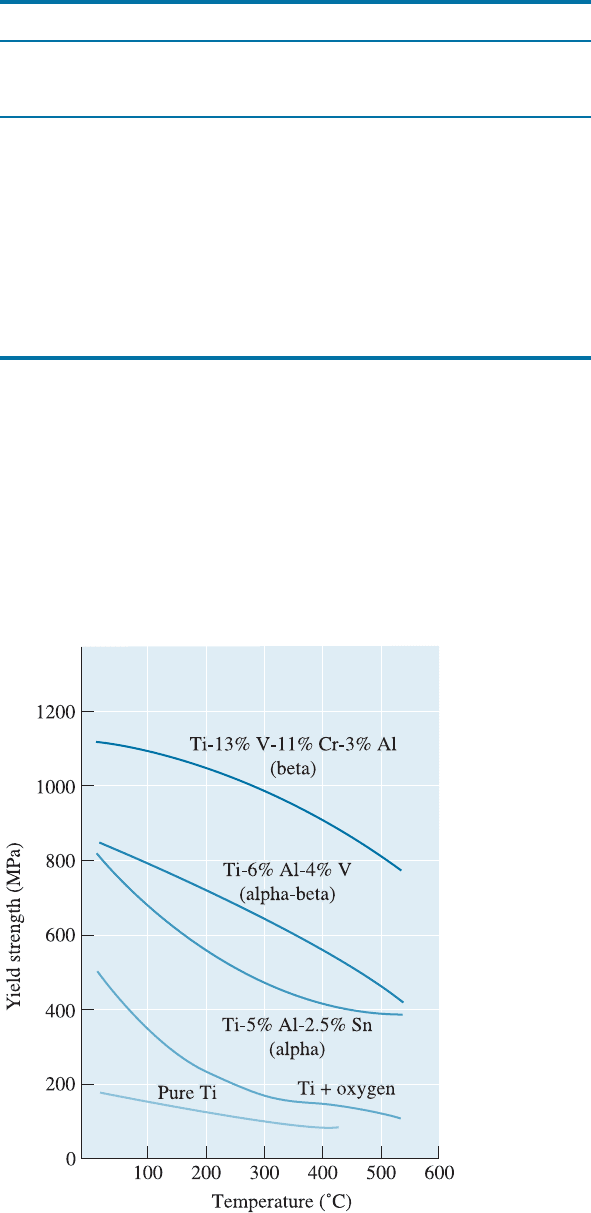
reducing the temperature at which the a–b transformation occurs and producing a two-
phase structure at room temperature. Several categories of titanium and its alloys are
listed in Table 14-9.
Commercially Pure Titanium Unalloyed titanium is used for its superior corrosion re-
sistance. Impurities, such as oxygen, increase the strength of the titanium (Figure 14-10)
but reduce corrosion resistance. Applications include heat exchangers, piping, reactors,
pumps, and valves for the chemical and petrochemical industries.
TABLE 14-9 9 Properties of selected titanium alloys
Tensile Yield
Strength Strength %
Material (MPa) (MPa) Elongation
Commercially pure Ti:
99.5% Ti 241 172 24
99.0% Ti 552 483 15
Alpha Ti alloys:
5% Al-2.5% Sn 862 779 15
Beta Ti alloys:
13% V-11% Cr-3% Al 1289 1214 5
Alpha-beta Ti alloys:
6% Al-4% V 1034 965 8
Figure 14-10
The effect of temperature on
the yield strength of selected
titanium alloys.
CHAPTER 14 Nonferrous Alloys456
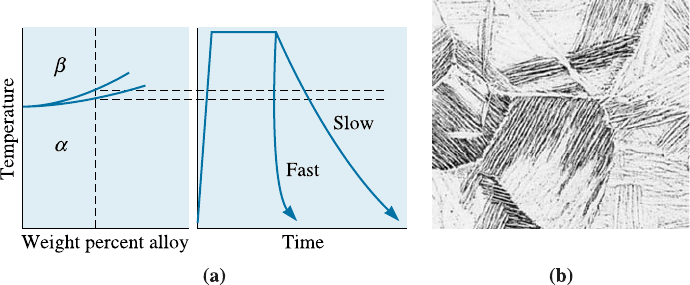
Alpha Titanium Alloys The most common of the all-alpha alloys contains 5% Al and
2.5% Sn, which provide solid-solution strengthening of the HCP alpha phase. The alpha
alloys are annealed at high temperatures in the b region. Rapid cooling gives an acicular,
or Widmanstðtten, a-grain structure (Figure 14-11) that provides good resistance
to fatigue. Furnace cooling gives a more plate-like a structure that provides better creep
resistance.
Beta Titanium Alloys Although large additions of vanadium or molybdenum produce
an entirely b structure at room temperature, none of the beta alloys are actually alloyed
to that extent. Instead, they are rich in b stabilizers, so that rapid cooling produces a
metastable structure composed of all b. Strengthening is obtained both from the large
amount of solid-solution-strengthening alloying elements and by aging the metastable b
structure to permit a to precipitate. Appl ications include high-strength fasteners, beams,
and other fittings for aerospace applications.
Alpha-Beta Titanium Alloys With proper balancing of the a and b stabilizers, a mix-
ture of a and b is produced at room temperature. Ti-6% Al-4%V, an example of this
approach, is by far the most common of all the titanium alloys. Because the alloys
contain two phases, heat treatments can be used to control the microstruc ture and
properties.
Annealing provides a combination of high ductility, uniform properties, and good
strength. The alloy is heated just below the b-transition temperature, permitting a small
amount of a to remain and prevent grain growth (Figure 14-12). Slow cooling causes
equiaxed a grains to form; the equiaxed structure provides good ductility and formability
while making it di‰cult for fatigue cracks to nucleate. Faster cooling, particularly from
above the a-b transus temperature, produces an acicular—or ‘‘basketweave’’—alpha
phase (Figure 14-12). Although fatigue cracks may nucleate more easily in this struc-
ture, cracks must follow a tortuous path along the bound aries between a and b. This
condition results in a low-fatigue crack growth rate, good fracture toughness, and good
resistance to creep.
Two possible microstructures can be produced when the b phase is quenched from
a high temperature. The phase diagram in Figure 14-13 includes a dashed martensite
start line, which provides the basis for a quench and temper treatment. The b transforms
Figure 14-11 (a) Annealing and (b) microstructure of rapidly cooled alpha titanium (100).
Both the grain boundary precipitate and the Widmanstðtten plates are alpha. ( From ASM
Handbook, Vol. 7, (1972), ASM International, Materials Park, OH 44073.)
14-5 Titanium Alloys 457
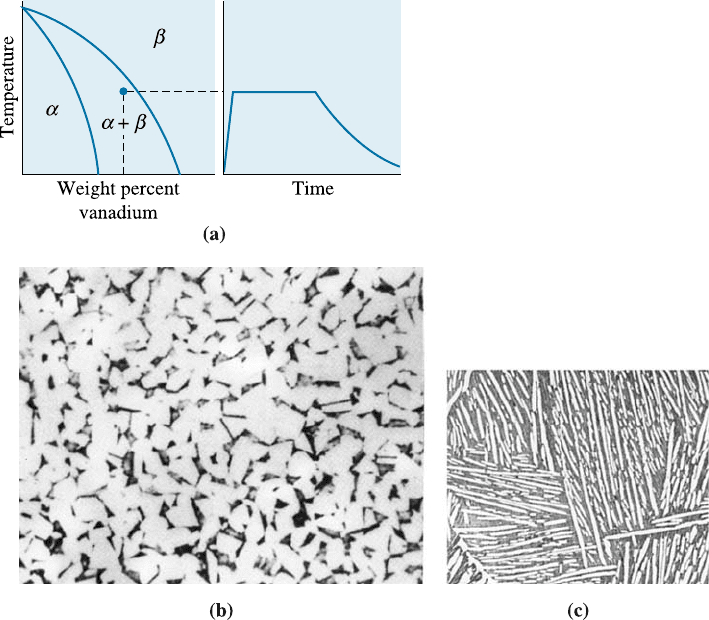
to titanium martensite (a
0
) in an alloy that crosses the M
s
line on cooling. The titanium
martensite is a relatively soft supersa turated phase. When a
0
is reheated, tempering oc-
curs by the precipitation of b from the supersaturated a
0
:
a
0
! a þ b precipitates
Fine b precipitates initially increase the strength compared with the a
0
, opposite to what
is found when a steel martensite is tempered. However, softening occurs when temper-
ing is done at too high a temperature.
More highly alloyed a-b compositions are age-hard ened. When the b phase in these
alloys is quenched, b
ss
, which is supersaturated in titanium, remain s. When b
ss
is aged,
a precipitates in a Widmanstðtten structure, (Figure 14-13):
b
ss
! b þ a precipitates
The formation of this structure leads to improved strength and fracture toughness.
Components for airframes, rockets, jet engines, and landing gear are typical applica-
tions for the heat-treated alpha-beta alloys. Some alloys, including the Ti-6% Al-4%V
Figure 14-12 Annealing of an alpha-beta titanium alloy. (a) Annealing is done just below the
a–b transformation temperature, (b) slow cooling gives equiaxed a grains (250), and (c) rapid
cooling yields acicular a grains (2500). (From Metals Handbook, Vol. 7, (1972), ASM
International, Materials Park, OH 44073.)
CHAPTER 14 Nonferrous Alloys458
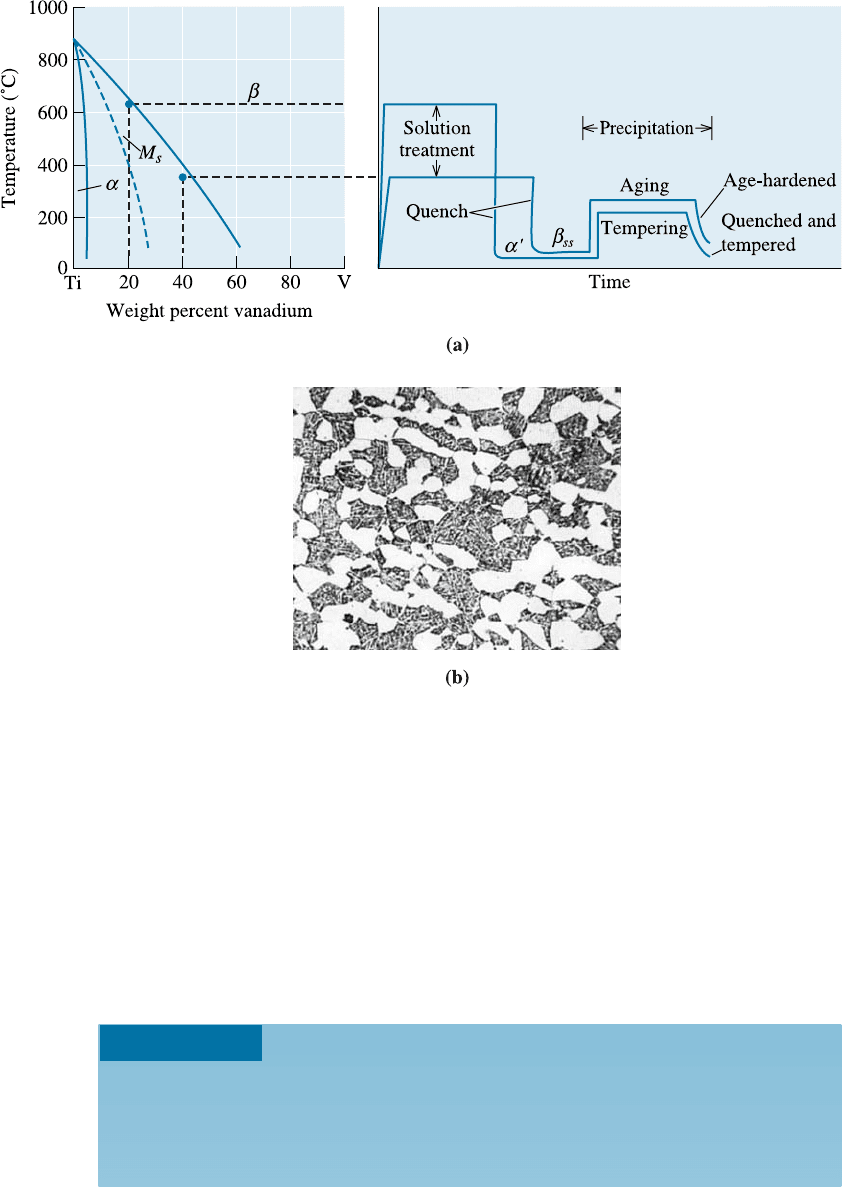
alloy, are superplastic and can be deformed as much as 1000%. This alloy is also used
for making implants for human bodies. Titanium alloys are considered biocompatible
(i.e., they are not rejected by the body). By develop ing porous coatings of bone-like
ceramic compositions known as hydroxyapatite, it may be possible to make titanium
implants bioactive (i.e., the natural bone can grow into the hydroxyapatite coating).
The following three examples illustrate applications of titanium alloys.
Figure 14-13 (a) Heat treatment and (b) microstructure of the alpha-beta titanium alloys. The
structure contains primary a (large white grains) and a dark b matrix with needles of a formed
during aging (250). (From ASM Handbook, Vol. 7, (1972), ASM International, Materials
Park, OH 44073.)
EXAMPLE 14-8
Fracture Toughness of Titanium 6246 Alloy
The fracture toughness of di¤erent titanium alloys is shown in Figure 14-14.
The short transverse (ST) direction is through thickness direction, while the
length ðLÞ is the longitudinal direction or the rolling direction. A titanium-alloy
6246 plate is exposed to a stress of 200 MPa. Calculate the flaw size for a crack
14-5 Titanium Alloys 459
